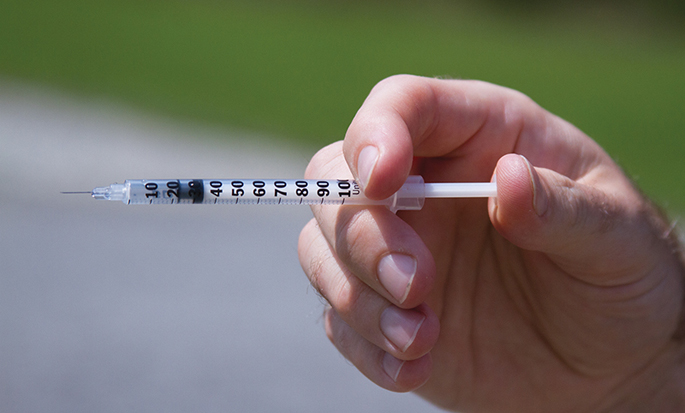
Bacterial infections are among the most unsightly and frustrating health issues that koi dealers and keepers alike are likely to experience in their journey. As a dealer, arming yourself with information on the causes, prevention and treatment of bacterial infections not only can keep your stock healthy, but it can also build trust and confidence in your customers.
How They Present
Bacterial infections manifest in koi in three ways — ulcers, fin rot and mouth rot. In each instance, the bacteria are eating away and destroying tissue on the body of the fish.
Ulcers begin as a red, raised patch of scales on scaled fish or as a small, circular, bluish-white spot on scaleless fish. Left unchecked, the ulcer will quickly progress to an open, typically circular hole in the fish’s body.Eventually, the ulcer will work its way through to the organs, causing death. Fin rot typically starts at the edge of the fins and works its way inward, although you may occasionally see holes in the middle of a fin. Mouth rot, which eats away at the tissue around the mouth area, commonly starts with abrasions or damage to the mouth. This is usually from the fish rubbing against nets or the sides of the tank, opening a pathway for the infection to set in.
The Two Offenders
The majority of bacterial infections in koi are caused bay one of two bacteria — pseudomonas and aeromonas. Both pseudomonas and aeromonas are naturally occurring and ubiquitous in pond and tank water. They are always there, and your fish are always exposed to them. You can never rid an aquaculture system of them completely.
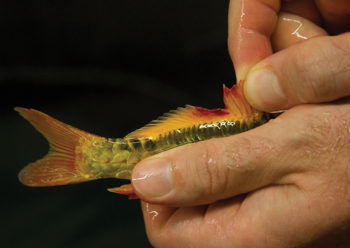
When discussing bacterial infections, I often liken pseudomonas and aeromonas to common viruses in humans. As a living, breathing being moving about the world, you are regularly exposed to viruses. When you’re healthy, with a fully functioning immune system, you don’t get sick. But when your health decreases, whether it’s through physical or environmental stress, malnutrition or any of a number of other stressors, your immune system weakens, and the likelihood of you becoming sick increases.
Similarly, koi are exposed to aeromonas and pseudomonas all the time. When the fish are healthy and their immune systems are fully functioning, they don’t become infected. But, if their immune systems are compromised in some manner, their natural resistance to the bacteria can start to fail, which often leads to infection.
There are many different stressors that can compromise or weaken a koi’s immune system and increase the likelihood that an infection will set in. Identifying, understanding and reducing or eliminating these stressors is key. Treating the infection in the fish without eliminating or reducing the underlying cause will only result in recurring infections.
Things to Look Out For
If your water quality is poor for an extended period of time, with parameters far outside the acceptable range for koi, this can stress your fish and lead to infection. Measuring water parameters, understanding what you’re seeing and knowing how to bring them back to acceptable levels is key, not only in bacterial infection prevention, but also in the overall health of your fish.
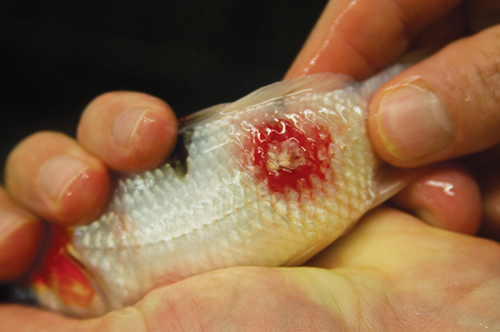
Overcrowding or overstocking a tank or pond can also quickly lead to bacterial infection. Not only does it stress the fish, but overstocking a pond with more fish than the filtration is equipped to handle can also quickly get you into trouble with the quality of your water.
Like all living beings, koi require a balanced diet in proper quantities in order to remain healthy. If your fish are not getting the nutrients they need or not enough food in general, their health will decline, and bacterial infections may be just around the corner.
Unchecked parasite infections can also drain the resources available to a fish’s immune system, weakening the immune-system function and increasing the likelihood of a secondary bacterial infection. Some parasites like anchor worms, fish lice and flukes can even punch tiny, microscopic holes into the protective slime coat on a fish, presenting an opportunity for the harmful bacteria to bypass the protective layer and begin eating away at the tissue underneath.
Control Your Levels
The levels of pseudomonas and aeromonas present in a pond or tank can vary greatly. Just because it’s naturally occurring doesn’t mean that it has to exist at a high level. Taking the proper steps to keep the bacteria levels in check will go a long way toward preventing infection.
Bacteria feed off the solid waste excreted by fish, and too much solid waste in the water column will result in a bacteria load that is too high to be considered healthy. A common mistake comes from hanging several nets in a tank and keeping fish in the nets with nothing swimming in the tank underneath. The solid waste from the fish in the nets sinks to the bottom of the tank and collects there. This is a breeding ground for harmful bacteria, but it is easily solved by keeping a few larger fish under the nets to keep the waste stirred up and headed down the drain and into your filter, where it belongs.

Properly cleaning your filters is key as well. Your mechanical filtration removes solid waste from the water column and traps it in the filter. The filter must be cleaned and flushed periodically in order to remove the solid waste and send it down the drain. Infrequent cleaning of the filter means that solid waste cannot be trapped by the filter media, resulting in more waste in the water. An improper cleaning technique can result in solid waste from the filter getting sent back into your tanks, where it’s harmful and stressful to the fish, instead of down the drain, where it belongs.
Water changes are also a valuable tool in the fight against bacterial infections. Regular and frequent water changes can help to control and lessen the bacteria load in a heavily stocked system. At times, we water change 10 to 20 percent per day in a heavily stocked system.
Solve the Problem
So, you’ve got bacterial infections in your fish, or you have a customer asking you about bacterial infections and how to treat them. Here are some options for treatment. But remember, treating is only half the battle. If you don’t combine treatment with reduction or elimination of the initial cause of the bacterial infections, they will only come back.
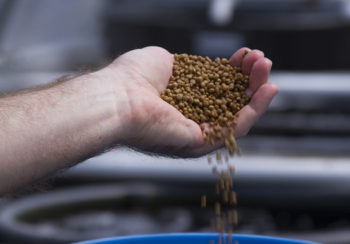
Ultraviolet (or UV) filters use ultraviolet rays to control the growth of organic bodies in your system water. UV filters will not have any curative effect and will not solely prevent bacterial infections from occurring, but they will help to reduce the bacteria population in your water and should be considered a part of your long-term solution.
Medicated koi food was recently removed from the U.S. retail market by the FDA in the fight against overuse of antibiotics. However, it is still possible in some instances to obtain a veterinarian prescription for antibiotics that can be top-dressed onto pellet food and fed to fish with bacterial infections.
While medicated food can heal fish that have just started to show minor symptoms of infection, it will not heal fish with advanced infections. The real advantage of medicated food comes in the form of prevention. We have regularly used medicated food in a population of fish where a small percentage showed signs of bacterial infection, and we felt that the majority of the population were not sellable because of their high likelihood of developing infections. A two-week application of medicated food ceased any further infections from developing. After a brief observation period, the fish can be deemed sellable once again.
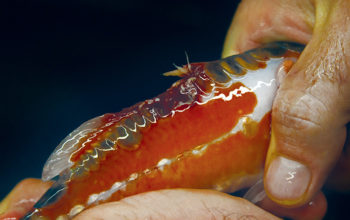
It is also possible to inject fish with antibiotics in order to halt a bacterial infection. The most common antibiotic used for injection is Baytril, which also requires a prescription. While injection is the most effective method for treating a bacterial infection, it is also the most difficult and expensive, and it is generally reserved only for high-value (whether in money or sentimentality) fish.
Tricide-Neo is an antibiotic dip developed at the University of Georgia for prevention and treatment of ulcers in koi. Although I do not have personal experience with Tricide-Neo, I have heard accounts from enough hobbyists to believe in its effectiveness in the treatment of bacterial infections.
When possible, heating pond or tank water up to 78 to 82 degrees can be beneficial in the fight against bacterial infections. Not only are bacteria less active at these temperatures, but the warm water also gives the koi an immune-system boost. Warm water alone will not prevent or heal bacterial infections, but it can be a helpful tool in combination with other treatment options, particularly antibiotics.
While ulcers are unsightly and frustrating to deal with, they don’t have to have a major negative impact on your short koi-selling window each year. Take steps to maintain a healthy environment and reduce stress in your stock. Be prepared to treat any issues that do happen to arise, and you can maintain steady fish sales while engendering trust and confidence in your fish customers.


